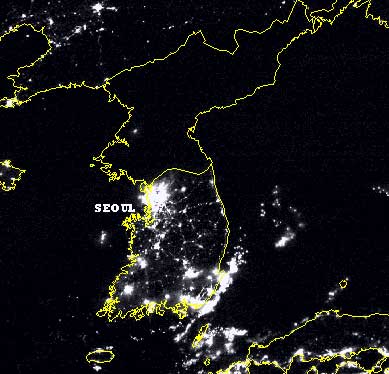Centrehalf
Well-Known Member
- Joined
- May 11, 2011
- Messages
- 719
What? Are you tripping on something? You've become incoherent.
Nope, not tripping at all. It was funny to watch you self-destruct today though.
What? Are you tripping on something? You've become incoherent.
Nope, not tripping at all. It was funny to watch you self-destruct today though.
Yeah. You blew it today with the whole Social Democrat thing.
North and South Korea seen from satellite......

"...The energy sector is one of the most serious bottlenecks in the North Korean economy. Since 1990 the supply of oil, coal, and electricity declined steadily, and seriously affected all sectors of the economy. Crude oil was formerly imported by pipeline at “friendship prices” from the former USSR or China, but the withdrawal of Russian concessions and the reduction of imports from China brought down annual imports from about 23 million barrels (3.7×106 m3) in 1988 to less than 4 million barrels (640×103 m3) by 1997. As the imported oil was refined for fuels for transportation and agricultural machinery, a serious cutback in oil imports caused critical problems in transportation and agriculture.
North Korea has no coking coal, but has substantial reserves of anthracite in Anju, Aoji (Ŭndŏk), and other areas. Coal production peaked at 43 million tons in 1989 and steadily declined to 18.6 million tons in 1998. Major causes of coal shortages include mine flooding, and outdated mining technology. As coal was used mainly for industry and electricity generation, decrease in coal production caused serious problems in industrial production and electricity generation. Coal production may not necessarily increase significantly until North Korea imports modern mining technology[original research?].
Electricity generation of North Korea peaked in 1989 at about 30 TWh. There were seven large hydroelectric plants in the 1980s. Four were along the Yalu River, built with Chinese aid, and supplying power to both countries. In 1989, 60% of electricity generation was hydroelectric and 40% fossil fueled, mostly coal-fired.
In 1997, coal accounted for more than 80% of primary energy consumption and hydropower more than 10%. Net imports of coal represented only about 3% of coal consumption. Hydroelectric power plants generated about 65% of North Korea's electricity and coal-fired thermal plants about 35% in 1997[citation needed]. However, with only 20% of the per capita electricity generation of Japan, the DPRK suffers from chronic supply shortages.
Some hydroelectric facilities are believed to be out of operation due to damages from major flooding in 1995. Coal-fired power plants have been running well under capacity in recent years, due in part to a serious decline in coal supply and in part to problems with transportation of coal. The electricity supply steadily declined and was 17 TWh in 1998. Since electricity generated should double up just to return to the 1989 level, power shortages will continue until coal production increases substantially and generating equipment is refurbished[original research?]. Transmission losses are reported to be around 30%[citation needed].
http://en.wikipedia.org/wiki/Economy_of_North_Korea
Comrade Sta Il Inn
Ah, good ol' sweden - I lived there for six months. And of course, they don't have socialism there, but rather social democracy - perhaps you should look up the difference between the two.






Rick, do you favor social democracy?
This is definitely the BEST of the socialism/capitalism comparisons. PERFECT!
Uh, noooooo..................
What???
OK, I'll play you're game.
Hey, did you get hurt when you walked into a wall today? Boy, you sure looked stupid!
